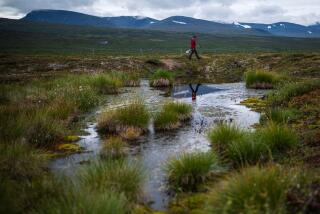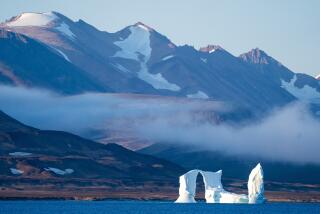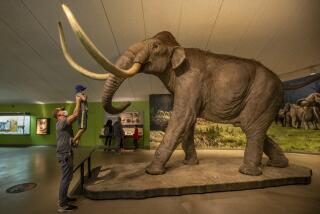The Arctic’s geological record indicates warming is human-caused
Long-term climate records from the Arctic provide strong new evidence that human-caused global warming can override Earth’s natural heating and cooling cycles, U.S. researchers reported this week in the journal Science.
For more than 2,000 years, a natural wobble in Earth’s axis has caused the Arctic region to move farther away from the sun during the region’s summer, reducing the amount of solar radiation it receives. The Arctic is now 600,000 miles farther from the sun than it was in AD 1, and temperatures there should have fallen a little more than 1 degree Fahrenheit since then.
Instead, the region has warmed 2.2 degrees since 1900 alone, and the decade from 1998 to 2008 was the warmest in two millenniums, according to a team headed by climatologist Darrell S. Kaufman of Northern Arizona University.
Not only was the last half-century the warmest of the last 2,000 years, “but it reversed the long-term, millennial-scale trend toward cooler temperatures,” Kaufman said.
The results seem to negate the primary argument of those who say the current warming of Earth is simply a natural variation, he said.
The Arctic region has actually warmed about three times as much as the rest of Earth through a well-known effect called Arctic amplification.
As reflective snow and ice melt and are replaced by dark water and vegetated surfaces that absorb more sunlight, trapped heat is released back into the atmosphere. The absorption also thaws permafrost, releasing greenhouse gases such as methane back into the atmosphere to increase warming even more.
The climate warming record was produced from tree rings, glacier ice and cores drilled in 14 lakes around the Arctic.
Layers of sediment provided a proxy for temperatures: thicker layers indicated higher temperatures as water from melting glaciers pushed mud into the lakes, while thinner layers indicated less melting.
All three data sources told the same story -- that the Arctic began to warm at the beginning of the Industrial Age in the mid-1800s, when humans began releasing large quantities of carbon dioxide into the atmosphere.
The temperature increase is supported by recent data showing that glaciers in the region are shrinking more rapidly than has ever been observed. As the glaciers shrink, they release water that raises ocean levels, threatening coastlines around the world.
Scientists have been debating how high the oceans will rise, but many say an increase of 6 to 9 feet is not out of the question if greenhouse gas release continues at the current rate.
The 21,000-year cycle of the axis wobble is now in its 7,000th year, and the Arctic will not reach its closest point to the sun for 14,000 more years.
--






